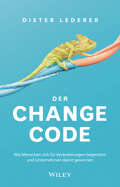- Table View
- List View
Der Businessplan: Geschäftspläne professionell erstellen Mit Checklisten und Fallbeispielen
by Anna NaglDieser bewährte nun bereits in der 9. Auflage erscheinende Leitfaden ermöglicht es dem Leser, einen maßgeschneiderten Businessplan zu erstellen, der strengsten Anforderungen genügt. Dabei beleuchtet die Autorin ausführlich in der neuen, überarbeiteten und aktualisierten Auflage auch den sehr facettenreichen Megatrend der Digitalisierung, der bei der Entwicklung von Businessplänen eine zunehmend wichtige Rolle spielt. Außerdem gibt es wieder viele Beispiele, Checklisten und nützliche Praxistipps.
Der Businessplan: Geschäftspläne professionell erstellen Mit Checklisten und Fallbeispielen
by Anna NaglDieser bewährte, nun bereits in der 10. Auflage erscheinende Leitfaden ermöglicht es den Lesern, einen maßgeschneiderten Businessplan zu erstellen, der strengsten Anforderungen genügt. In die neue Auflage sind die Entwicklungen und Erkenntnisse der Corona-Pandemie (Covid-19) eingeflossen. Neu ist außerdem ein Praxisbeispiel zu gängigen Methoden der Unternehmensbewertung. Darüber hinaus gibt es wieder viele Beispiele, Checklisten und nützliche Praxistipps.
Der Change-Code: Wie Menschen sich für Veränderungen begeistern und Unternehmen damit gewinnen
by Dieter LedererFakten führen zum Denken, Emotionen führen zum Handeln. Die Quote ist seit Jahren unverändert: Drei Viertel aller Change-Programme in Unternehmen gehen schief. Sie liefern nicht das, was sie sollen. Mit der Folge, dass Geld, Motivation und Wettbewerbsfähigkeit schwinden. Klar ist: So kann es nicht weitergehen. Angesichts der immensen Herausforderungen und Umbrüche, vor denen wir allenthalben stehen, ist es höchste Zeit, dass der Pfusch beim Change aufhört. Wie das funktioniert, verrät dieses Buch - mit einer überraschend einfachen Lösung: Es lädt dazu ein, konsequent auf das zu fokussieren, was Menschen brauchen, um sich für Wandel zu begeistern. Denn nur dann werden sie sich bewegen. Nur dann werden sie sich vertrauensvoll auf eine neue unternehmerische Richtung einlassen und sie kraftvoll umsetzen. Das Kompendium menschenorientierter Veränderung und Transformation.
Der Content-Coach: Leitfaden für bessere Inhalte und durchdachte Strategien im Content-Marketing
by Florian Schauer-BiecheVorsicht: dieses Buch ist nichts für Theoretiker. Dieses Buch ist für Macher und Umsetzer. Sind Sie zufrieden mit Ihrer Kommunikation? Ist Ihr Content gut genug, um die Konkurrenz abzuhängen? Wenn nicht, springen Sie gleich zu Seite 1. Sie halten hier Ihren persönlichen Content-Coach in den Händen. Egal ob Sie Unternehmer, Manager oder einfach ein an Content interessierter Mensch sind: Dieses Buch ist für alle, die nicht länger „irgendwas mit Content“ machen wollen, sondern künftig von sich behaupten möchten: Ich weiß wie es geht! Lernen Sie die Grundlagen der menschlichen Kommunikation und Storytelling. Holen Sie sich Anleitungen aus der Praxis. Die Tipps dieses Buches kommen aus dem echten Leben. Es sind Antworten auf Fragen und Aufgaben von Kunden und Seminarteilnehmern. Die Lösungen, die Sie hier erhalten, haben den Reality-Check bestanden. Der Content-Coach begleitet Sie bei der Ideenfindung und der Konzept- und Strategieentwicklung, der Contenterstellung, der Prozessentwicklung und beim Training Ihrer Mitarbeiter. Aus dem InhaltIst Ihre Herangehensweise bei der Erstellung von Inhalten richtig?Wie erzählt man Geschichten? Wie wird eine Idee zur Story?Welches Basiswissen braucht ein Content-Creator?Wie erstellt man gute Inhalte und was macht gute Inhalte aus? Wie wertet man die Content-Arbeit innerhalb von Unternehmen auf?Wie vermarktet und verbreitet man Inhalte?Wie sieht der Content der Zukunft aus und sind Sie dafür gerüstet? Der AutorFlorian Schauer-Bieche ist Content-Coach, Design-Thinker und Kommunikationsberater. Er berät internationale Unternehmen und hält Vorträge und Seminare. Der „gelernte“ Journalist ist umtriebiger Unternehmer und Gründer der Initiative „BreakTheRules.Today“ und hat skill.casa ins Leben gerufen, die erste Content-Agentur für Sprachassistenten in Österreich.
Der Cyber-Versicherungsmarkt in Deutschland: Eine Einführung (essentials)
by Umar ChoudhryDiese Dokumentation schlägt eine Schneise durch das Dickicht des Versicherungsmarktes der Cyber-Policen. Versicherungen gegen Cyberkriminalität werden zunehmend wichtiger: Angriffe auf die Informationstechnik von Unternehmen können Schäden in Millionenhöhe hinterlassen, beispielsweise wenn sensible Datensätze gestohlen oder Seiten von Online-Shops lahmgelegt werden. Inzwischen bietet die deutsche Versicherungswirtschaft mit speziellen ,,Cyber-Policen" Schutz gegen eine Vielzahl von IT-Risiken. Doch wie schlagkräftig ist ein solcher Schutz? Welche Versicherer bieten spezielle Cyber-Policen an? Welche Gefahren können versichert werden? Welche Rolle spielt der Versicherungsvertrieb und worauf sollten Vermittler und Makler achten? Das sind nur einige der Fragen, denen Umar Choudhry nachgeht.
Der DiSG-Code: So knackst Du mit dem Persönlichkeitsprofil den Kunden und verkaufst besser
by Georg DauthWer sich selbst sowie seine Kunden als Typen besser einordnen kann, kann sich besser auf sein Gegenüber und dessen Bedürfnisse einstellen. Der Kunde baut Vertrauen auf. Verkäufer und Vertriebler lernen, mit Menschen umzugehen, was wiederum beiden Seiten Freude bereitet. Der Kunde fühlt sich rundum verstanden, was dem Verkäufer zurückgespiegelt wird und auch ihn weiterbringt. Erfolg stellt sich dann von selbst ein. Hier hilft das DiSG®-Persönlichkeitsprofil. Es setzt sich mit grundsätzlichen Eigenschaften von Menschen auseinander. Es gibt dabei 4 Grundtypen: Dominant, Initiativ, Stetig und Gewissenhaft. Wenn man sich dieser Typen in der täglichen Kommunikation bewusst ist, kann man sich zielgerichtet darauf einstellen. Von diesem Wissen können Verkäufer und Vertriebsmitarbeiter ganz klar profitieren. In seinem neuen Buch stellt Georg Dauth deshalb DiSG® in den Zusammenhang mit dem Sales-Prozess. Es werden die Grundlagen erläutert und hilfreiche Praxisanleitungen gegeben. DiSG®-Expertenwissen wird mit vielen Beispielen belegt und der Leser erfährt, wie er damit erfolgreich Abschlüsse im Verkauf und Vertrieb erzielen kann.
Der Digital Navigator: Ein Modell für die digitale Transformation
by Thomas MohrDie Digitalisierung bietet ohne Frage großartige Chancen und hat unendliches Innovationspotential. Gleichzeitig bereitet sie vielen Unternehmern Kopfzerbrechen. Dies liegt nach Ansicht des Autors am Fehlen anerkannter, einheitlicher und vor allem praktikabler Management Tools zur Unterstützung der digitalen Transformation.Diese Lücke schließt der Autor mit seinem „Digital Navigator“-Ansatz. Er macht deutlich, was für die digitale Transformation eines Unternehmens notwendig ist und wie diese erfolgreich durchgeführt werden kann.Das Buch ist in zwei Teile gegliedert: Der erste Teil dient dem Aufbau eines generellen Verständnisses zur Problematik und zeigt, wie ein Modell hier unterstützen kann. Im zweiten Teil geht es um die praktische Anwendung des Digital Navigators. So dient dieser als Rahmen für die Erarbeitung von Digitalisierungsstrategien und als „Kompass“ auf dem Weg der digitalen Transformation. In einem konkreten Vorgehensmodell wird schließlich skizziert, wie der Digital Navigator in der Praxis verwendet werden kann. Dieser praktische Leitfaden für die Umsetzung will den Leser an die Hand nehmen und aufzeigen, was im Einzelnen zu tun ist.
Der Direktvertrieb in Mehrkanalstrategien: Eine Einführung mit Beispielen für die Umsetzung (essentials)
by Christian FriegeDieses Essential bietet einen Einblick in die Chancen und Herausforderungen des Direktvertriebs und gibt Hilfestellungen für die Wahl des passenden Direktvertriebsmodells. Ob der klassische Vertreterverkauf oder ein komplexeres Partyplanmodell gewählt werden und wie diese in den Mehrkanalvertrieb integriert werden können, sind grundlegende Entscheidungen und stets wiederkehrende Herausforderungen, die in jedem Fall zu treffen und zu bewältigen sind. Sowohl Produktkriterien (Erklärungsbedürftigkeit, Emotionalisierung) als auch das Geschäftsmodell (Tragfähigkeit für Vertriebsprovisionen, Win-win-win-Konstellation) spielen dabei eine entscheidende Rolle. Wie das in der Praxis funktioniert, wird an drei beispielhaften Konzepten mit Checklisten für die direkte Anwendung in der Praxis gezeigt.
Der Dispositionseffekt als relevantes Anlegerverhalten: Einführung in die Erklärungsansätze und in die empirischen Befunde (essentials)
by Sebastian HaaseSebastianHaase beschreibt den Dispositionseffekt als Ph#65533;nomen und sp#65533;rt den Urspr#65533;ngen diesesForschungsfeldes nach. Er stellt verschiedene Erkl#65533;rungsmodelle f#65533;r denDispositionseffekt dar, wie z. B. Mean Reversion, die Prospect Theory, MentalAccounting und den Seeking-Pride-Avoiding-Regret-Ansatz. Zudem erfolgt ein nachInvestorengruppen differenzierter #65533;berblick der wesentlichen empirischenErkenntnisse und der Autor skizziert die wesentlichen experimentellen Studienzum Dispositionseffekt.
Der Eigensinn der Triebwagenführenden – Geschlechterkonstruktionen in Rationalisierungskonflikten (Geschlecht und Gesellschaft #83)
by Joana CoppiDie öffentliche Dienstleistungsbranche, deren paradigmatische Berufe – Verkehrsplanung und Lok- bzw. Triebwagenführen – männlich segregiert und codiert sind, ist seit den 1990er-Jahren von Privatisierungstendenzen, deren Infragestellung seit der Finanzkrise sowie einer Prekarisierung der Arbeitsbedingungen geprägt, die mittlerweile in Fachkräftemangel umschlägt. Am Beispiel des öffentlichen Nahverkehrs wird untersucht, wie Geschlechterdifferenz in Konflikten über die Daseinsvorsorge, auch als Reaktion auf gesellschaftliche Transformation, hergestellt wird. In gesellschaftlichen Transformationsprozessen erweisen sich Geschlechterordnungen als veränderbar, aber auch als beharrlich. In welcher Wechselwirkung mit aktuellen Geschlechterordnungen stehen die unterschiedlichen Modi, in denen Geschlechterdifferenz aktiviert oder nicht aktiviert wird? Diese Frage beantwortet die Studie, indem Expert*innenwissen zum Begriff der Daseinsvorsorge, zu den Beschäftigungsbedingungen von Triebwagenführenden und zu betrieblichen Gleichstellungspolitiken hermeneutisch rekonstruiert wird. Theoretisch sensibilisierend wird die feministische Rationalisierungsforschung herangezogen, um die Konflikte um Transformation im Handlungsfeld geschlechtertheoretisch einordnen zu können, während das Konzept des Androzentrismus zentral ist, wenn das ‚Vergessen‘ von Differenz erfasst werden soll. Ziel der Untersuchung ist es, Deutungsmuster in Rationalisierungskonflikten um den Schienenpersonennahverkehr und darin enthaltene Herstellungsweisen von Geschlechterdifferenz zu rekonstruieren. Dabei zeigt sich, dass eine Rekonstruktion des Geschlechterwissens in gesellschaftlichen Konfliktlagen besonders geeignet ist, die vielfältigen Modi herauszuarbeiten, mit denen Geschlechterhierarchien im Wandel stabilisiert werden.
Der Einfluss der Digitalisierung auf die Wirtschaftsprüfungsbranche und die Ausbildung zukünftiger Wirtschaftsprüfer: Entwicklung eines Kompetenzframeworks (Controlling und Rechnungslegung - Managerial and Financial Accounting)
by David DangDie Wirtschaft, Gesellschaft und privates Leben betreffende digitale Transformation beeinflusst auch den Berufsstand des Wirtschaftsprüfers bedeutsam. Technologische Innovationen wie Big Data, Cloud Computing und Continuous Audit ermöglichen der Wirtschaftsprüfungsbranche, ihre Dienstleistungen neu gestalten und verbessern zu können. Sowohl öffentliche als auch private Organisationen berichten, dass die größte Herausforderung in Zeiten der Datenrevolution darin besteht, Fachkräfte mit den erforderlichen Kompetenzen zu rekrutieren, um die Vorteile von Big Data zu nutzen und die Daten in verwertbare Erkenntnisse zu transformieren. Trotz einer zunehmenden Anzahl an Studien existiert bislang ein begrenztes Verständnis für die Bedeutung der Digital- und Datenanalysekompetenzen für die Wirtschaftsprüfungsbranche. Insbesondere die Studien, die Diskrepanzen zwischen den vom Arbeitsmarkt benötigten Kompetenzen und den Kompetenzen untersuchen, die die Hochschulabsolventen besitzen, stellen ein hochinteressantes Forschungsfeld dar. Mit Hilfe eines Mixed-Method-Ansatzes in der Datenerhebung wird die oben beschriebene Forschungslücke adressiert. Die Untersuchung fokussiert sich auf die Ausbildung der abgefragten Kompetenzen.
Der Einfluss des Beschwerdekanals auf das Kündigungsverhalten (Applied Marketing Science / Angewandte Marketingforschung)
by Stefan GardingIn der aktuellen Forschung zum Beschwerdemanagement wurden die unterschiedlichen Auswirkungen von interaktiven und schriftlichen Beschwerdekanälen auf den Erfolg einer Beschwerdebearbeitung noch nicht untersucht. Die vorliegende Studie schließt diese Forschungslücke. Die empirische Untersuchung von Unternehmensdaten legt nahe, dass Beschwerden über schriftliche Beschwerdekanäle im Vergleich zu interaktiven Beschwerdekanälen zu einer geringeren Kündigungshäufigkeit nach einer Beschwerde führen können. Dieser positive Effekt ist stärker für Beschwerden von älteren Kunden und bei schwerwiegenden Fehlern in der Dienstleistung. Die Dauer der Geschäftsbeziehung zwischen Kunde und Unternehmen hat hingegen keinen Einfluss auf die Kündigungshäufigkeit im Vergleich der Beschwerdekanäle. Potenzielle Selbstselektionseffekte in der Wahl des Beschwerdekanals durch den Kunden werden durch ein statistisches Matching-Verfahren reduziert. Das Risiko einer Verzerrung der Ergebnisse durch mögliche Unterschiede in der Qualität der Beschwerdebearbeitung wird durch einen post-hoc Test minimiert. Die Ergebnisse der Studie sind für Theorie und Praxis relevant.
Der Einfluss des Betreuungsangebotes auf die Entscheidung zur Mutterschaft bei Akademikerinnen (BestMasters)
by Isabella GeorgiDer demografisch bedingte Fachkräftemangel gefährdet die Stabilität des Arbeitsmarktes und Sicherung der Sozialsysteme. Eine Steigerung des Geburtenverhaltens könnte die drohenden Konsequenzen langfristig abwenden. Mit dem Ausbau der Betreuungsinfrastruktur hat sich die hohe Kinderlosigkeit in Deutschland stabilisiert. Die Vereinbarkeit von Familie und Beruf wird jedoch weiterhin als unzureichend empfunden. Es stellt sich daher die Frage, ob ein besseres Betreuungsangebot die Kinderlosigkeit senken könnte. Für die Entscheidung zur Mutterschaft weist die Autorin eine signifikant stärkere wahrgenommene Verhaltenskontrolle und Intention durch das bedarfsgerechte Betreuungsangebot im Vergleich zum derzeitigen Betreuungsangebot nach. Für die Vereinbarung von Mutterschaft und Karriere konnte ebenfalls eine signifikant stärkere wahrgenommenen Verhaltenskontrolle und Intention durch das bedarfsgerechte Betreuungsangebot im Vergleich zum derzeitigen Betreuungsangebot ermittelt werden. Die Effekte waren als groß zu bewerten. Die Ergebnisse verdeutlichen, dass ein bedarfsgerechtes Betreuungsangebot die Entscheidung zur Mutterschaft sowie die Vereinbarung von Mutterschaft und Karriere positiv beeinflusst.
Der Einfluss des Neoliberalismus auf die deutsche Gesundheitspolitik: Das Beispiel der gesetzlichen Krankenversicherung (Gesundheit. Politik - Gesellschaft - Wirtschaft)
by Michael SimonDieses Buch bietet eine Untersuchung des Einflusses neoliberaler Denkmuster auf die deutsche Gesundheitspolitik seit 1945. Der Einfluss wird untersucht und aufgezeigt am Beispiel der gesetzlichen Krankenversicherung, die von zentraler Bedeutung für das deutsche Gesundheitswesen ist.Das Buch wendet sich an alle Wissenschaftsdisziplinen, die sich mit Gesundheitspolitik und insbesondere Fragen der Ausgestaltung der gesetzlichen Krankenversicherung befassen. Darüber hinaus bietet es auch Akteuren der Gesundheitspolitik vielfältiges Material und Hintergrundwissen über die historische Entwicklung der Gesundheitspolitik und zentrale Fragen der Ausgestaltung der gesetzlichen Krankenversicherung.Mit seinem Erscheinen in der Reihe „Gesundheit. Politik-Gesellschaft-Wirtschaft“ (hrsg. von E.-W. Luthe und J.N. Weatherly) steht das Buch für die wachsende Erkenntnis, Gesundheitspolitik als interdisziplinäre Aufgabe zu betrachten.
Der Einfluss unbewusster Motive auf den Entscheidungsprozess: Wie implizite Codes Managemententscheidungen steuern
by Christian ChlupsaDieses Buch hilft, die unbewussten Motive hinter Entscheidungen zu verstehen. Es zeigt, wie man implizite Codes erkennen und diese für die eigene Kommunikation nutzen kann. Dabei greift das Werk auf die neuesten verhaltensökonomischen Erkenntnisse zurück. Jeden Tag treffen Manager hunderte von Entscheidungen in der Annahme, diese seien rational fundiert. Doch der Großteil unserer Wahrnehmung ist implizit und so verwundert es nicht, dass auch der größte Teil unserer Entscheidungen in Wahrheit unbewusst abläuft.Die 2. Auflage wurde grundlegend überarbeitet, neue Inhalte und Testverfahren integriert und um aktuelle Forschungen anerkannter Wissenschaftler, aber auch um eigene Forschungsergebnisse ergänzt. Ein neues Kapitel stellt drei Praxisbeispiele vor, die die Erkenntnisse der impliziten Kommunikation in ihrer Markenführung umgesetzt haben. Implizite Kommunikation setzt genau dort an, wo gute Kommunikation beginnt – im Kopf. Ein implizites Gesamtkonzept hilft, Kommunikation mit größtmöglicher Wirkung zu gestalten.
Der Einfluss von Bewusstseinslagen auf die Wahrnehmung von Earnings Management und die Rolle der professionellen Skepsis in der Wirtschaftsprüfung: Eine experimentelle Untersuchung (Controlling und Rechnungslegung - Managerial and Financial Accounting)
by Sophia DangDas vorliegende Buch beschäftigt sich mich dem stets relevanten Thema des Earnings Managements. Dieses Thema ist ein anhaltendes Problem für die Wissenschaft und Praxis und wird in der vorliegenden Arbeit aus Sicht der Wirtschaftsprüfung experimentell untersucht. Dazu wird mit Teilnehmern einer Big-Four-Wirtschaftsprüfungsgesellschaft ein Experiment unternommen, in dem beide Arten des Earnings Managements - Accrual-based Earnings Management und Real Earnings Management - betrachtet werden. Zudem wird untersucht inwiefern sich eine planende und eine abwägende Bewusstseinslage auf die Wahrnehmung durch die Wirtschaftsprüfer auswirken. Die professionelle Skepsis eines jeden Teilnehmers wird ebenfalls durch das Experiment erhoben und quantifiziert und die Auswirkungen dieser auf die Wahrnehmung von EM werden untersucht.
Der Einfluss von ESG auf das Kreditrisiko: Eine Analyse europäischer Unternehmensanleihen
by Anna GappmaierDie zunehmende Relevanz von ESG (Environmental, Social, and Governance) in der finanzwirtschaftlichen Forschung und Praxis wird angetrieben durch Wesentlichkeit, Investorennachfrage und Regulatorik. Weil Initiativen im Bereich ESG für Unternehmen mit (hohen) Kosten verbunden sind, stellt sich die Frage, ob sich die Investitionen in Bezug auf eine höhere Performance bzw. ein geringeres Risiko „lohnen“. Die bisherige Forschung konzentriert sich v. a. auf die Shareholder-Value-Perspektive. Jüngere Studien untersuchen ESG aus einer Risikoperspektive, vorwiegend eigenkapitalbasiert. Untersuchungen zum Wirkungszusammenhang zwischen ESG und dem Kreditrisiko sind noch spärlich gesät, insbesondere für den europäischen Raum. Aus einer Prinzipal-Agent-theoretischen Sichtweise kann angenommen werden, dass Gläubiger ESG-Investitionen anders bewerten als Eigentümer. Für Gläubiger steht die Bedienung ihrer Zahlungsansprüche aus dem Cash Flow im Vordergrund, sie befürworten grundsätzlich weniger risikoreiche Investitionen. Ziel dieser Untersuchung ist es, einen umfassenden Überblick über die bisherige empirische Literatur zu geben und diese mittels einer eigenen empirischen Untersuchung zu erweitern.
Der Einfluss von activity based working auf die Arbeitszufriedenheit: Eine Mixed Methods Studie (BestMasters)
by Ina ErovicActivitiy based working wird immer häufiger in Unternehmen umgesetzt. Der Grundgedanke von aktivitätsbasierten Arbeiten ist es, dass für die täglich variierenden Tätigkeiten der Mitarbeitenden vielfältige Arbeitsumgebungen benötigt werden. In Abhängigkeit von der anstehenden Tätigkeit, aber auch den persönlichen Vorlieben des Mitarbeitenden wählt dieser eine für sich passende Arbeitsumgebungen aus. Die vorliegende Arbeit legt den Schwerpunkt darauf, die Auswirkungen von activity based working auf die Arbeitszufriedenheit der Nutzer*innen zu identifizieren.
Der Einkauf im Wandel: Jetzt souverän, innovativ und krisenfest die Zukunft gestalten
by Tanja Dammann-GötschWie es gelingt, dass der Einkauf der Zukunft bestmöglich performt und das mit Mitarbeitenden, die als Unternehmensgestalter agieren, zeigt die ausgewiesene Einkaufsexpertin Tanja Dammann-Götsch anhand verschiedener Faktoren wie Digitalisierung, Purpose, Agilität, Human Touch, Homeoffice und Co. auf. Mit praktischen Anleitungen sowie anhand von Beispielen erklärt sie, wie sich der Einkauf modern, strategisch und innovativ gestalten lässt. Dabei liegt der Fokus nicht nur auf Zahlen, Daten und Fakten, sondern vielmehr auf den Menschen und kreativen Lösungen im Einkauf. Essenzielle Fragen, wie beispielsweise: Welche Mitarbeitenden braucht der Einkauf der Zukunft? Welche Kompetenzen zeichnen diese aus? Welche Art der Führung brauchen Einkäufer in Zukunft? beantwortet die Autorin ebenfalls. Dieses Buch läutet die Aufholjagd ein, die im Einkauf dringend nötig ist, um im internationalen Wettbewerb zu bestehen. Ziel ist es, den Einkauf souverän und langfristig für die Zukunft aufzustellen. Ein stabil aufgestellter Einkauf ist in der Lage, mit Krisensituationen wie Lieferengpässen, insolventen Lieferanten, knappen Rohstoffen oder neuen Gesetzen umzugehen. Zudem hat der Einkauf der Zukunft keine Defizite in der Digitalisierung, ist innovativ, stellt sich als attraktiver Arbeitgeber auf und kann so auch in Zeiten des Fachkräftemangels gute Mitarbeitende finden und binden. Durch eine Zukunftsausrichtung gelingt es ebenfalls, sich mit der Globalisierung und den großen kommenden Themen in puncto Sustainability gewinnbringend auseinanderzusetzen.
Der Einsatz externer Mitarbeiter in Bundesministerien: Eine politikwissenschaftliche Analyse (essentials)
by Andreas MaischAndreas Maisch untersucht den Personalaustausch zwischen öffentlichem Dienst und Privatwirtschaft, der in der Öffentlichkeit teilweise als eine neue Form des Lobbyismus betrachtet wird. Dabei analysiert der Autor, wie sich die Anzahl der externen Mitarbeiter seit dem Jahr 2008 entwickelt hat und welche Faktoren ihre Anzahl am stärksten beeinflussen. Des Weiteren betrachtet er, wie groß die Einflussmöglichkeiten der externen Mitarbeiter sind und ob das Ziel der Bundesregierung erreicht wurde, einen gegenseitigen Personalaustausch mit der Wirtschaft zu etablieren. Im Jahr 2004 hatte die rot-grüne Bundesregierung das Personalaustauschprogramm ,,Seitenwechsel" gestartet, um das gegenseitige Verständnis zwischen öffentlichem Dienst und Privatwirtschaft zu verbessern.
Der Einsatz psychologischer Testverfahren in Unternehmen: Ein Leitfaden für Anwender und solche, die es werden wollen (essentials)
by Thomas SteiningerThomas Steininger beantwortet in diesem essential die wichtigsten Fragen zum Einsatz psychologischer Testverfahren im Unternehmenskontext. Er liefert einen Praxisleitfaden für Personalentwickler, Recruiter, Berater und Coaches, die Testverfahren in Unternehmen anwenden möchten. Hierzu werden zunächst die Fragen beantwortet, was psychologische Testverfahren sind, welche Arten sich unterscheiden lassen und woran man qualitativ hochwertige Verfahren erkennen kann. Anschließend werden praxisorientierte Hinweise gegeben, wie sich schrittweise ein passendes Verfahren auswählen lässt und was bei der Anwendung in Unternehmen sowie der Interpretation der Ergebnisse beachtet werden sollte.
Der Einsatz von Chatbots in Business-to-Business-Märkten: Eine empirische Analyse der Nutzerakzeptanz (BestMasters)
by Kathrin ElsnerDie Digitalisierung nimmt maßgeblichen Einfluss auf die Wettbewerbsfähigkeit von Unternehmen und bietet gleichermaßen neue Möglichkeiten, mit Kunden in Kontakt zu treten. Künstliche Intelligenzen, wie z. B. Chatbots, sind heute allgegenwärtig und nehmen sowohl auf unser Arbeits- als auch auf unser privates Umfeld Einfluss. Während Chatbots im B2C-Bereich bereits vielfältig genutzt werden, steht der Einsatz von Chatbots im B2B-Sektor noch in den Anfängen und fand in bisherigen Studien kaum Beachtung. Das vorliegende Buch setzt an dieser Stelle an und untersucht auf Basis des Technologie-Akzeptanzmodells nach Davis, welche Determinanten Einfluss auf die Akzeptanz von Chatbots in der externen Kommunikation nehmen. Ziel ist es, die einzelnen Determinanten der Akzeptanz zu verstehen, um eine nachhaltige und erfolgreiche Nutzung sicherzustellen und somit die Wettbewerbsfähigkeit von Unternehmen zu gewährleisten.
Der Einsatz von Social Media Walls zur Kundeninspiration am Beispiel der Tourismusbranche (BestMasters)
by Luisa JustDas vorliegende Buch beleuchtet den Einsatz von Social Media Walls als Marketinginstrument und deren Einfluss auf die Kundeninspiration am Beispiel des Tourismussektors. Die Arbeit verfolgt das Ziel, Erfolgsfaktoren zu identifizieren, die eine Social Media Wall aus Kundenperspektive auszeichnen. Zudem beantwortet sie, inwiefern sich der Einsatz von Social Media Walls auf die Kundeninspiration auswirkt. Zur Beantwortung der Forschungsfragen wird eine systematische Literaturanalyse durchgeführt. In Ergänzung dazu erfolgt eine statistische Auswertung der empirisch erhobenen Daten mittels Strukturgleichungsmodellierung. Die empirische Untersuchung durchleuchtet Erfolgsfaktoren von Social Media Walls, die die Kundeninspiration beeinflussen können. Dazu zählen die Qualität der Informationen der Social Media Wall, die wahrgenommene Ähnlichkeit der Interessen zwischen Website-Besucher und Schöpfer der Inhalte sowie der Unterhaltungswert dieser Inhalte. Die Ergebnisse zeigen, dass Social Media Walls eine kostengünstige Möglichkeit für Unternehmen darstellen, Konsumenten zu inspirieren. Die Kundeninspiration wiederum hat positive Auswirkungen auf verschiedene Aspekte des Kundenverhaltens, einschließlich emotionaler Bindung, Kundenbegeisterung und Kaufabsichten. Dies führt zu gesteigerter Kundenzufriedenheit und Kundenloyalität.
Der Einspruch im Steuerrecht
by Sylvia Meier Ute SpohrerDas Buch gibt einen Überblick über das Einspruchsverfahren und erläutert Vor- und Nachteile gegenüber dem Antrag auf schlichte Änderung. Häufige Fehlerquellen wie die Fristbereichnung werden praxisnah mit zahlreichen Beispielen und Checklisten dargestellt. Als weitere Arbeitshilfen liefert das Werk Mustereinsprüche, um die ersten Schritte im Einspruchsverfahren zu erleichtern.
Der Einspruch im Steuerrecht: Grundlagen und Praxis
by Sylvia Meier Ute RakowskiDas Buch gibt einen Überblick über das Einspruchsverfahren und erläutert Vor- und Nachteile gegenüber dem Antrag auf schlichte Änderung. Häufige Fehlerquellen wie die Fristberechnung werden praxisnah dargestellt. Als weitere Arbeitshilfen liefert das Werk Mustereinsprüche, um die ersten Schritte im Einspruchsverfahren zu erleichtern. In der 3. Auflage wurde zudem neue Rechtsprechung und Verwaltungsanweisungen berücksichtigt sowie die Arbeitshilfen aktualisiert.
























